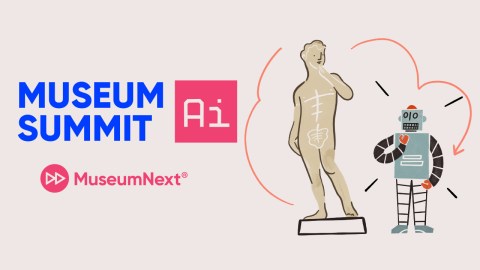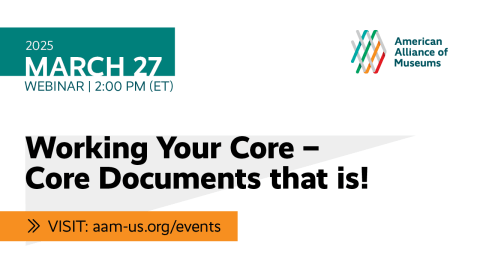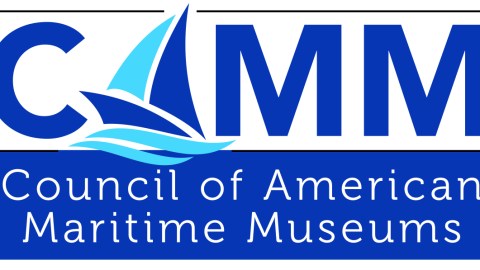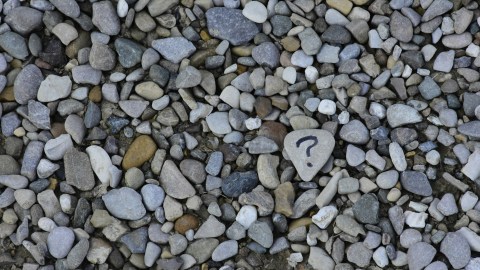
I joined Twitter in 2009, soon after the launch of CFM. That was the first social media account associated with AAM, and trying out this new realm was part of CFM’s work exploring emerging digital tools and their significance for museums. As it turned out, the accessibility and reach of networks like Twitter, and platforms like independent blogs, were critical to the success of AAM’s new “think tank and idea lab.” Currently @futureofmuseums has a bit under 63 thousand followers on Twitter, and I use the account to share interesting news and research, signal boost opportunities for training and engagement, and look for information to inform my forecasting.
However, for the past two weeks I’ve spent the majority of my networking time on another service that’s been gaining traction, Mastodon, where I have an account as @eemerritt@glammr.us (and am connected with a grand total of 19 other people. So, work in progress.) Today I want to offer a primer on Mastodon, with some thoughts on why you might also want to spend some time exploring alternative (i.e., non-commercial) social networks.
What is Mastodon?
Mastodon is a microblogging platform that is decentralized, distributed across the Fediverse, based on open source code, and run by volunteers.
- Microblogging means “designed to host very short pieces of text.” Twitter, the most well-known microblogging site, accommodates 280 characters; Mastodon posts can be up to 500 characters.
- Decentralized means that rather than being hosted on servers owned by one company, Mastodon is hosted on servers owned by many different individuals or organizations. Mastodon is made up of over seven thousand separate servers (each called an “Instance”) that can connect with each other using common protocols—this collection of interconnected servers is called the Fediverse. Within this federated universe of servers, anyone with a Mastodon account can follow and connect with anyone on any Instance.
- This distributed network is possible because Mastodon, the nonprofit company founded in 2016, makes Mastodon, the code, available for free to as open source code that anyone can download, edit, and run on their own server.
- Mastodon Instances are hosted and moderated by volunteers. They are not designed to generate income from advertising, though some Instance hosts invite support by donations via platforms such as Patreon. Because Mastodon is not a commercial company trying to maximize revenue, what users see is not controlled by algorithms designed to maximize engagement by rewarding salacious or divisive content.
Why Is It Trending in the News?
The short answer is because Elon Musk is making a spectacle of himself. (It is painful to watch the trainwreck that is his takeover of Twitter, but hard to look away.) Even last year the dominance of major commercial social networks seemed unassailable. Now it seems entirely possible that Facebook (with its parent company Meta) and Twitter may flame out or implode. Twitter because Musk, Facebook because Mark Zuckerberg has bet the house on the “Metaverse,” using technology that is far from mature to fill a need that may not exist.
Questionable business decisions aside, there are growing concerns about the pernicious effects of the business model that fuels the revenue of Twitter and Meta. Both have been criticized for tolerating abusive content and signal-boosting misinformation that fosters genocide, far-right violence, climate denial, and anti-vax campaigns. Lawmakers and regulators are concerned that the Chinese company ByteDance, which owns TikTok and WhatsApp, may be using these platforms to spy on US citizens. YouTube (owned by Google) has been accused of facilitating the spread of extremism and child sexual exploitation. Efforts to curb such abuses may lead to regulations that restrict access to or weaken the business model of these platforms.
Why Should Museums Care?
Two reasons, one pragmatic and the other based on values.
Pragmatic: Many museums use “free” social media platforms as a key part of their communications strategy, using TikTok, YouTube, Twitter, and Facebook to communicate with existing fans, reach new audiences, manage their image, and engage with the public.
Overreliance on any given platform is vulnerable to changes in terms of use, policies, algorithms, and the platforms’ continued existence. In 2014, when Facebook recoded its algorithm to favor organizations that paid to boost their posts, many museums that had become accustomed to free found themselves having to pay to reach their intended audiences. In 2021, some museums found themselves banned from TikTok for posting nude artwork. Museums would do well to be aware of the vulnerabilities of relying on these free platforms, prepared to adapt to changes in their terms of use, and ready to migrate to new platforms if circumstances warrant.
Values: The dominant services dominate because they spend a ton of money on promotion—and they can spend that ton because they are making money by exploiting our attention and our data. Why do we use them? Partly because we (by which I mean human beings) are lazy—these networks are easy to join, everyone else is using them, and they are nominally “free.” But they aren’t really free—they bear hidden costs to us individually and to society as a whole. Though social media platforms help many people connect and amplify important messages, in their quest for more of our attention they have encouraged us to be bad actors and pay attention to bad actors. They amplify the voices of small numbers of extremist individuals, and by doing so create a false impression of the prevalence of these extreme views. They have become platforms for bullying and shaming (and this before Musk fired the majority of staff responsible for policing behavior on Twitter). We can’t enjoy the benefits provided by commercial social networks without taking responsibility for the harm done by their business models.
What Can You Do to Respond?
This might be a good time to become familiar with alternative social networks—not just other platforms built on the same economic premise as the big ones, having the same weaknesses, but ones created with different values and economies. Many, including Mastodon, are community-operated, decentralized, free, open-source, privacy-focused, and ad-free.
Instead of Twitter, try Mastodon or Counter Social.
Instead of Facebook, Friendica or MeWe.
Instead of Goodreads (which is owned by Amazon) try BookWyrm.
Instead of YouTube (Google) try PeerTube.
Instead of Instagram (Meta) try Pixelfed.
One challenge inherent in changing to any of these alternatives, though: critical mass. These platforms only work if you can find people there, and right now it can seem a bit like playing Marco Polo in an empty pool. (Like me on Mastodon, talking to 18 followers.) But museum people, as a sector, can tackle this together via mass migration. If Mastodon becomes the place to go for museum content, people will follow. I think the larger challenge is finding non-commercial platforms museums can use to connect with the general public. If museums choose to remain on commercial platforms, they might want to consider how to offset the harms these platforms do, similar to how some purchase carbon offsets to mitigate the impact of staff travel. What might an offset for the negative impacts of commercial social networks look like? Perhaps, on the part of both organizations and individuals, it could involve fostering civil behavior and countering disinformation and hate.
Practical Tips on Joining Mastodon
Here are few tips in response to questions and concerns I’ve seen expressed on social media:
- Don’t worry too much about which Instance (Mastodon community) you join. Once you have joined, you have access to all the other Instances in the Fediverse. (Other than those that have been barred for bad behavior.) Some of the oldest and largest Instances, overwhelmed by Twitter refugees, are not currently accepting new members.
- Join Mastodon via your computer browser, where the process is super simple. After you have an account you can download any of a number of apps (which are also independently created) if you prefer to access Mastodon via your phone.
- If you want to try to port your Twitter friends and followers over to Mastodon, there are a number of services offering to do just that, including Twitodon and Debirdify. (I have not done that yet because I’m curious to see how long it takes to build a new network of connections from scratch.)
Final Thoughts
Is the demise of current social media giants a good thing?
In some ways, perhaps. Besides the charges of bad acting on the part of the corporations through intent or negligence (see above) there is significant data that social media has a negative effect on body image (particularly for women, and teens), can increase loneliness and isolation, and interfere with the development of healthy social relationships. But a future without Twitter or Facebook or their ilk would not be an unalloyed good. Twitter has become a critical tool in emergency management and disaster response. While digital social networks have helped hate groups to coalesce and egg each other on, they also have provided a way for individuals isolated and marginalized for their identity (e.g., LGBTQ youth) to connect with people like them for emotional, social, and practical support. One challenge for government, as regulators, and each of us, as consumers and users: How can we keep these good aspects of social networks, while suppressing the bad? I look forward to hearing your thoughts. Maybe on Mastodon?








Nice piece! Very informative and thoughtful: it makes me wonder what comments we’d have about transitions between earlier “platforms” (eg. from spoken to written word, written to printed books, etc.). These are always fraught with difficulty (the earliest printed books were typically more costly than written ones). Eventually, their use became second nature, and over time almost completely “open source”. Investors and speculators are the chief obstacles to digital communications becoming “communalized”.
Wasn’t there a Mastodon server catered for Museums?
https://glammr.us/home
According to Mastodon Migration today, 16-Dec-2022: “Averaging 3000 to 4000 new users per hour. Mastodon continues to run pretty smoothly. Over 70,000 new users in the last 24 hours puts us on track for over 80,000 today.”
If you haven’t joined Mastodon, you should try it out. The experience, without an AI deciding what to feed you, without trolls, without hatred posts, is so much better.
Join any instance where the moderation policies match your own. You can read them by clicking “about” on the Website. Join any server and you are connected to the entire network. People are tempted to find the larger instances, but it’s unnecessary, and because of the growth, there can be performance issues. A new or smaller instance is just fine.
@Jerry@hear-ye.com